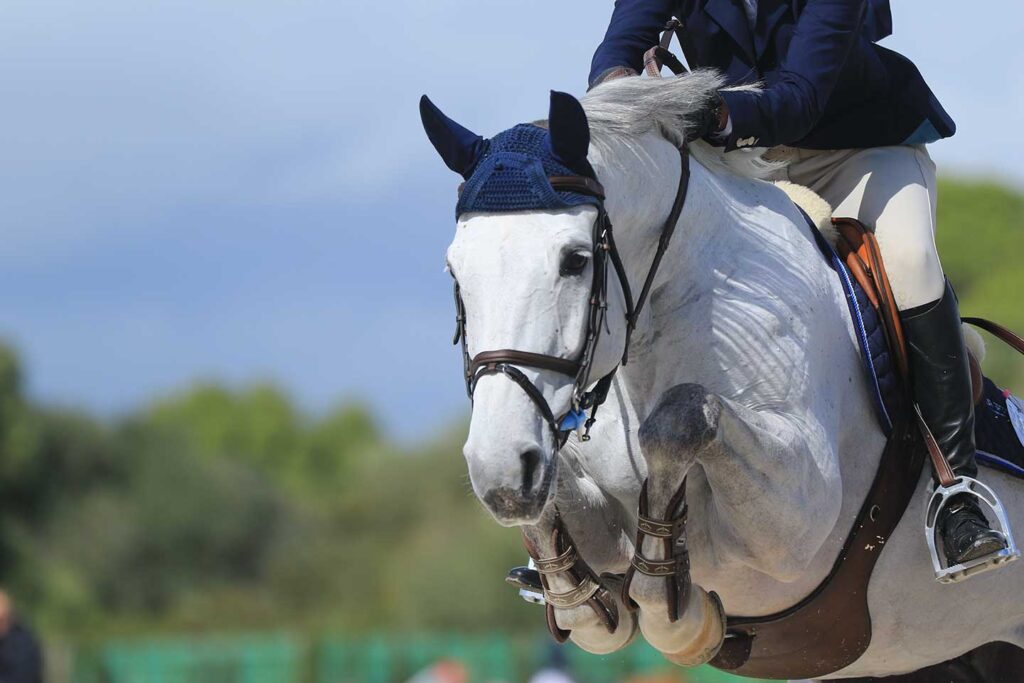Horses that are in work have vastly different nutritional needs than horses that are inactive. However, it’s the level of activity that determines how to best feed our performance horses. Horse activity level is divided into four categories: light, moderate, heavy, and very heavy. Horses in light activity are those used for events like trail and pleasure rides, where the work is mainly done at the walk. These horses generally work 1-3 hours per week. Those in moderate work include school horses in a lesson program and those used for frequent showing, but in disciplines that are less strenuous. These horses usually work for 3-5 hours per week. Looking at the heavy work category, we start to see horses that work for 4-5 hours per week but undergo strenuous speed or jumping work during their training — polo horses and those in low to medium level event training, for example. Horses in very heavy work spend the bulk of their training doing strenuous activities including speed and jumping work and may work anywhere from 6-12 hours per week. These include elite racehorses and elite event horses. While these categories are general labels and every horse should be treated as an individual, they give us a good idea of where to start when feeding our performance horses.
Energy is the first nutrient that is required in higher amounts in the working horse, and energy needs increase as the level of work increases. The source of that energy is just as important as the amount. The first source of energy we see in equine nutrition products is soluble carbohydrates, also called non-structural carbohydrates (NSC), or sugars and starch. These are found mainly in grains, like corn, and sweetening agents, like molasses. When a horse digests soluble carbohydrates, the breakdown products are absorbed in the small intestine. The problem with NSC is that when digested they can cause an increase in blood glucose and insulin that can lead to metabolic disturbances and increase the risk for tying up and ulcers. It’s critical that we don’t feed too much NSC and overload the small intestine with them. If this happens, the starch that doesn’t get digested in the small intestine passes into the hindgut where it is fermented, which can cause acidosis, diarrhea, and even laminitis.
If starches and sugars can be dangerous when fed in high amounts, what can we substitute as a safer energy source? The answer is fats, and this ingredient is actually the preferred energy source of the horse. As we train our horses and they increase in physical fitness, their bodies shift naturally from using carbohydrates for energy to using fats for energy. Fats are also more energy dense, meaning that a small amount of fat can hold a much larger amount of energy. Like sugar and starch, fats are absorbed in the small intestine but do not cause a large metabolic disturbance, so they are safer than sugars and starches. Some excellent sources of fats in the horse’s diet are flaxseed and rice bran.
In addition to energy, water is another nutrient that is greatly affected as the horse starts to work. Performing horses lose massive amounts of water as they sweat, and this loss can lead to dehydration and heat stroke. In moderate climates, horses can lose 6-8 L of sweat per hour. In hotter climates, like what we see in a typical south eastern summer, this loss can increase to 15 L per hour. One L of sweat weighs about 2 pounds, so in a hot climate a horse can lose up to 30 pounds of bodyweight per hour.
There is a common myth in the horse industry that says we should not let a hot, tired horse drink directly after work because it will make him colic or founder. Actually, withholding water is the worst thing you can do when your horse is hot or tired. Research has shown that your horse has his greatest thirst immediately after exercise. If we withhold water until the horse isn’t hot anymore, he may not feel thirsty but could still be in need of rehydration. Numerous studies have shown that letting a hot horse drink will cause neither colic nor founder. In fact, letting a hot horse drink is the best way to help him cool down. As a rule of thumb, allow your horse water at all times, whether he is hot or not.
Electrolytes are another class of nutrients that working horses need. All horses should have free choice access to a salt block, but performance horses need a little extra in terms of electrolytes. There are many choices of electrolyte supplementation available, and the first is top-dressing, or adding an electrolyte powder directly to the grain mix. You can also dissolve electrolytes in water. Some electrolytes are available in paste form, or you can create your own paste by mixing a commercial electrolyte powder with applesauce or plain yogurt.
Along with electrolytes, vitamins play a large role in the health of the performance horse. Fat soluble vitamins include Vitamins A, D, E and K. Vitamin D is made by the skin in response to sunlight, and Vitamins A, E and K come primarily from fresh, green forages. Water soluble vitamins include the B-vitamins, thiamin, riboflavin and Vitamin C. Vitamin C is a nutrient we’re beginning to realize is very important in the performance horse. Vitamin C works closely with Vitamin E as a significant antioxidant and is important for good muscle health.
 While the performance horse does have increased vitamin requirements, these needs usually increase in proportion to energy. In other words, if we feed our horses better grain and hay, or increase the daily amounts fed in the horse’s diet, generally we are already meeting these vitamin needs. The one exception to this may be Vitamin E, which is critical in protecting the body from oxidative damage. This is increasingly important in the working horse, as the muscle breakdown and rebuilding these horses go through can increase the oxidative products in the body. Vitamin E is found mostly in fresh green grass, so if you have a hard working horse that has little or no access to pasture it may be a good idea to feed a supplemental Vitamin E.
While the performance horse does have increased vitamin requirements, these needs usually increase in proportion to energy. In other words, if we feed our horses better grain and hay, or increase the daily amounts fed in the horse’s diet, generally we are already meeting these vitamin needs. The one exception to this may be Vitamin E, which is critical in protecting the body from oxidative damage. This is increasingly important in the working horse, as the muscle breakdown and rebuilding these horses go through can increase the oxidative products in the body. Vitamin E is found mostly in fresh green grass, so if you have a hard working horse that has little or no access to pasture it may be a good idea to feed a supplemental Vitamin E.
The next nutrient important to working horses is probably the most misunderstood in the horse industry – protein. Performance horses do have elevated protein needs over those horses who aren’t working, but the increase is not huge. What we actually see now in the performance industry is horses being overfed protein. Excess protein is detrimental as it can stress the liver and increase fatigue and dehydration. Since excess protein cannot be utilized for energy in the body, it is excreted in the horse’s urine as ammonia. Urine high in ammonia has a very bad smell when it builds up on the stall floor and can cause respiratory problems in horses.
With protein, it’s all about QUALITY, not quantity. Horses need grams of amino acids, not just a percentage of crude protein. Providing a high quality protein source (such as soybean meal) is vital in giving the horse the building blocks he needs to build strong muscle and bone. It doesn’t matter how much protein we give them – if this protein is of poor quality and doesn’t have the correct amino acids, the horse can’t use it and it will leave the body as waste in the urine.
Feeding the Equine Athlete
Beth Stelzleni, M.S., PAS


